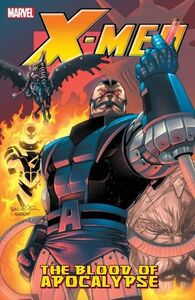You need to sign in or sign up before continuing.
Take a photo of a barcode or cover
A good premise poorly executed. Bad writing (uninspired dialogue, corny jokes) completely undermines Apocalypse as villain who should have extreme arrogance and power to back it up. The story rushes through what should be dramatic moments (Apocalypse at the UN). The art is overly digital and lacking in detail or a sense of movement. Big disappointment
In writing about the beginning of Joss Whedon's run on Astonishing X-Men, I mentioned that it should be taught to all potential X-Men writers as how to write a great X-story. Similarly, I think the Milligan run on X-Men should be taught, as every chapter leading up to this, the climax of his run, is utter garbage. It's one-star drivel that appears aimless and poorly thought out. And yet, somehow, Milligan wraps every thread up into a coherent ending.
It's still terrible. The characters don't behave like they do in anyone else's run, but they are consistent with the way Milligan has written them. The Apocalypse problem is solved way too easily, given the buildup. The way the company-wide event (Decimation/The 198) fits into this storyline works but doesn't accomplish anything.
Unlike the rest of his run, which made me roll my eyes so hard that I feared there might be permanent damage, I found myself reading every word. Instead of just asking "why would someone write this" (I was still asking this question, but now there was room for other thoughts), I was asking "how did he make this terrible story come together".
Most of the worst X-books start out with an idea and then fail to deliver. This book takes every terrible strand of Milligan's run, as well as some of the threads from Claremont's equally terrible concurrent run on Uncanny, as well as some strands from House Of M, and creates a tapestry. It's an ugly tapestry. But it's not a tapestry that looks like it was made by an amateur. It looks like it was made by a professional with terrible taste. Like when an artist seems to have no grasp of anatomy, but when you look at their work, you realize they draw everyone's necks in the same giraffe-like fashion, or all of their characters have Y-shaped skeletons. It looks terrible but purposeful.
This is the worst book I've given three stars to. You might not be as fascinated by its stupidity as I am. The dialog, not as stiff as in previous volumes, is still awkward. The characterizations, particularly of Gambit, Rogue, and Mystique, is incredulously ludicrous. The events still feel entirely manufactured to get the story to its merciful conclusion. But they do get the story there. It seems to accomplish exactly what Milligan envisioned. So...kudos?
I still can't recommend reading this for any reason other than deconstructing it.
It's still terrible. The characters don't behave like they do in anyone else's run, but they are consistent with the way Milligan has written them. The Apocalypse problem is solved way too easily, given the buildup. The way the company-wide event (Decimation/The 198) fits into this storyline works but doesn't accomplish anything.
Unlike the rest of his run, which made me roll my eyes so hard that I feared there might be permanent damage, I found myself reading every word. Instead of just asking "why would someone write this" (I was still asking this question, but now there was room for other thoughts), I was asking "how did he make this terrible story come together".
Most of the worst X-books start out with an idea and then fail to deliver. This book takes every terrible strand of Milligan's run, as well as some of the threads from Claremont's equally terrible concurrent run on Uncanny, as well as some strands from House Of M, and creates a tapestry. It's an ugly tapestry. But it's not a tapestry that looks like it was made by an amateur. It looks like it was made by a professional with terrible taste. Like when an artist seems to have no grasp of anatomy, but when you look at their work, you realize they draw everyone's necks in the same giraffe-like fashion, or all of their characters have Y-shaped skeletons. It looks terrible but purposeful.
This is the worst book I've given three stars to. You might not be as fascinated by its stupidity as I am. The dialog, not as stiff as in previous volumes, is still awkward. The characterizations, particularly of Gambit, Rogue, and Mystique, is incredulously ludicrous. The events still feel entirely manufactured to get the story to its merciful conclusion. But they do get the story there. It seems to accomplish exactly what Milligan envisioned. So...kudos?
I still can't recommend reading this for any reason other than deconstructing it.
The last gasp of an overly angsty villain as camp. The tone of the book is set from the first line of dialogue: "I've got an even better idea, Lord Apocalypse. Why don't we kill them all?"
I went back to this to remember where we stood with Apocalypse at the beginning of Uncanny X-Force. Milligan is talented, but his characters act in bizarre, over the top ways. Putting all of this into the villain of Apocalypse ends up being a good match. In many ways, though, the plot's a rehash, a cover version of previous storylines. Apocalypse looms large, transforms some X-Men characters and newly introduced characters into his Horsemen, pronounces doom for humanity, and gets defeated. But in retrospect, he never returned in this form again. Remender's X-Force took Apocalypse into new and unprecedented territory. Right now, this stands as the strange last run of the guy with the big "A" on his belt. On its own, however, the book isn't a satisfying read. Salvador Larocca's stiff art does little to aid the equally stiff characters going through the plot motions. Like so much of Milligan and Larocca's run on this title, the old fun elements are present, but don't come together in a satisfying way.
I went back to this to remember where we stood with Apocalypse at the beginning of Uncanny X-Force. Milligan is talented, but his characters act in bizarre, over the top ways. Putting all of this into the villain of Apocalypse ends up being a good match. In many ways, though, the plot's a rehash, a cover version of previous storylines. Apocalypse looms large, transforms some X-Men characters and newly introduced characters into his Horsemen, pronounces doom for humanity, and gets defeated. But in retrospect, he never returned in this form again. Remender's X-Force took Apocalypse into new and unprecedented territory. Right now, this stands as the strange last run of the guy with the big "A" on his belt. On its own, however, the book isn't a satisfying read. Salvador Larocca's stiff art does little to aid the equally stiff characters going through the plot motions. Like so much of Milligan and Larocca's run on this title, the old fun elements are present, but don't come together in a satisfying way.


